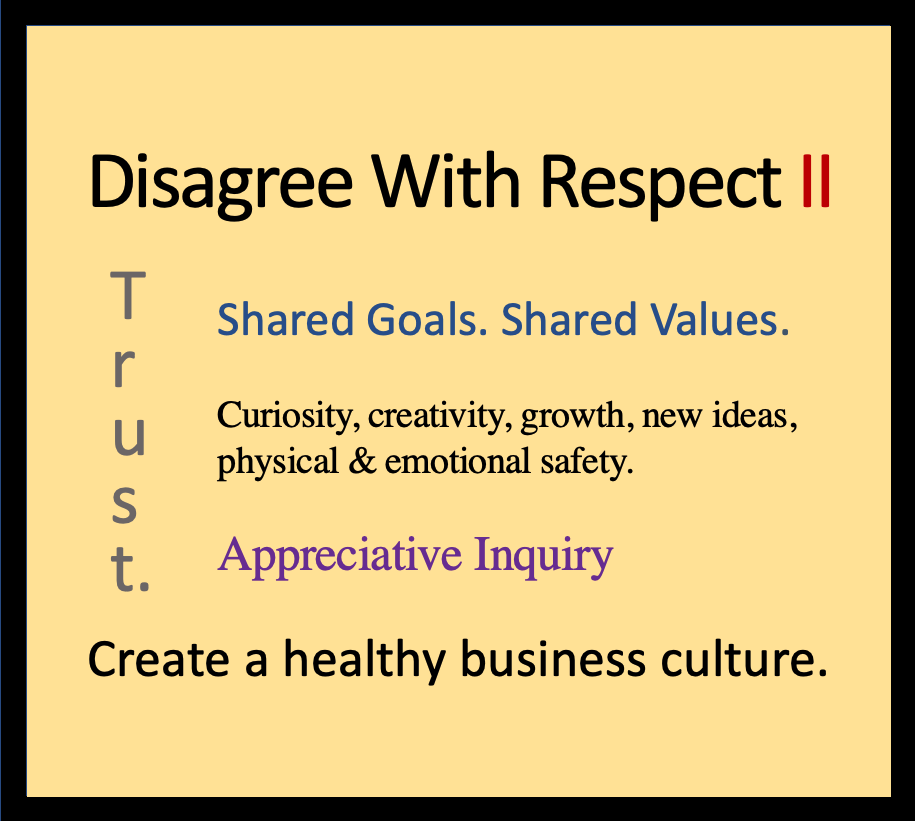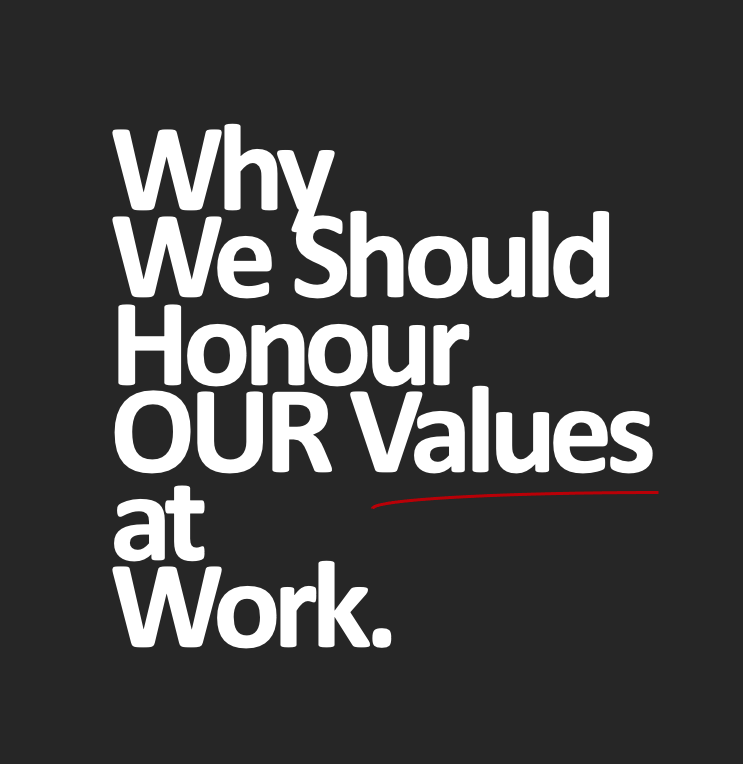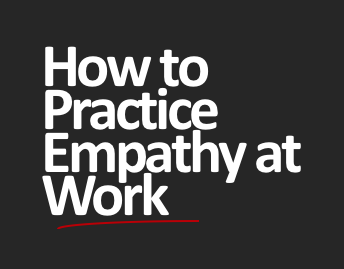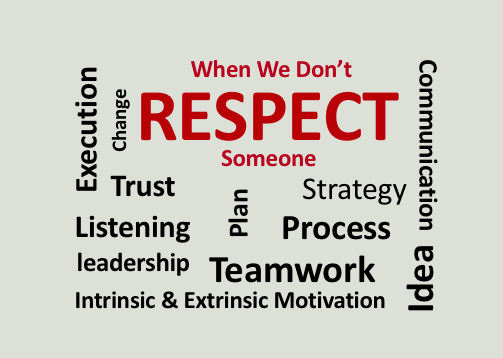Disagree With Respect At Work: Part II
/When you and I approach a problem and disagree with respect, it’s an opportunity for us to work as a productive team, to be creative, and build stronger relations as we build trust, loyalty, and pride in our outcomes.
In my previous article called Disagree With Respect At Work: Part I, I discuss three critical building blocks of a culture (at work or at home), where we can safely and respectfully explore different points of view. ‘Rules of Engagement’ is one of the three building blocks I discuss in Part I. With those Rules of Engagement we are able to be part of a culture – a workspace or family – where everyone can trust they will be safe and supported and therefore able to be their whole, honest, true self with all of their passion, creativity and flaws.
As I wrote in Part I, especially when stakes are high, there is more to having successful, respectful difficult conversations than only those three critical building blocks. So, here is Part II where I share three more that we can all use to help us have successful difficult conversations and be able to disagree with respect at work, with family and even with strangers. These three additional approaches are:
Be Intentional About Time and Place
Have Conversations In-person, By Phone or By Video
Share Stories Instead of Assigning Blame
Lets dive right in.
Be Intentional About Time and Place
Even when we are in a trusting culture there will always be a level of anxiousness when we disagree. Simply by its nature, disagreement makes most of us feel vulnerable. But it’s important we do our best to create a time and place where everyone feels safe, respected and not rushed. Let me share three less than ideal examples:
It’s not a good time or place to disagree with your boss while they are giving a project update to their boss. Doing this will immediately damage your reputation and destroy trust. This would also signal you are not a team player – and likely a half-dozen other unfavourable characteristics. This may also damage your bosses reputation as a leader.
It’s not a good time to raise a disagreement with your co-worker when they are working hard to meet a different important end-of-day deadline and they also have to pick up their 6-year-old from daycare before it closes. In this example you are adding a stressful moment when they have to push back on your request and begin negotiating a better time.
It’s not a good time or place to disagree with your partner in front of your child and their new boyfriend about how late they can stay out.
I bet that even as you read these examples, you felt – actually felt – these were not good times or places. These situations risk unwelcome feelings like surprise, humiliation, frustration, embarrassment, and more. I think we can all imagine many different other times or places for each of these examples where we could have disagreed with respect.
Have Conversations In-person, By Phone Or By Video
It’s near impossible for you and I to feel empathy and caring from an email or text message. In fact, we are more likely to feel the opposite. So, while sending an email or text message may feel ‘safe’ for you, please avoid disagreeing in writing. To disagree with respect I strongly encourage you to try to have these conversations in person… and if not in-person, try to hear each other’s voice. A happy middle-ground is a video conversation where everyone is on-camera (no blank screens).
This isn’t conjecture. Studies back-up this best-practice. Professor Julia Schroeder at UC Berkley and her colleagues say, “Listening to someone’s voice is humanizing as they make a contradictory or controversial argument. It makes it easier to engage with what that person has to say.” When a person feels empathy or genuine curiosity, it goes a long way to feeling respected.
So, when you disagree, know that a 5-minute face to face conversation can have far greater impact than the email you spend 20, 30 or perhaps even 60-minutes writing. If it is important to have a physical record, go ahead and write a brief email after you have had the in-person, phone or video call.
Share Stories Instead Of Assigning Blame
Facts are important. Stories make a situation real.
We know sharing disagreement in person, by phone or by video call engages our empathy. Sharing stories takes our ability to disagree with respect to a whole other level. Stories also builds connection between people and events which supports greater trust and understanding. Stories also make the situation far more memorable.
To disagree with respect at work, your stories should get to the point quickly. Don’t let your stories drag on. In my Difficult Conversation Training Workshops I encourage participants to consider starting their story by answering ‘Why’ the conversation is important at the beginning before they share ‘What happened’. Talking about ‘Why’ first does two things. First, it helps the other person (or people) feel safe and want to listen; to not put their defences up. Second, stories help them care and be curious. For example, consider the difference in being on the receiving end of the following two options with the second starting with ‘Why a conversation is important’ and the first and second examples being more inclined to immediately put Tom on the defensive:
Bad Example: “Tom, you talk over me in meetings and when you do, this makes me feel undervalued. I want you to stop.”
Bad, But Better Example: “Tom, you talk over me in meetings and when you do, this makes me feel undervalued. I want to discuss this with you because I want us to have creative conversations and a respectful work relationship.”
Ideal Example: “Tom, I have something important I’d like to share with you because I want us to have creative conversations and a respectful work relationship. When you talk over me in meetings it makes me feel undervalued. I’d like to work with you to find ways we could work together better.”
In the first example, the main goal isn’t to have Tom stop talking over them; it actually feels like the main goal is to assign blame. The second example is better, but still has the chance to immediately trigger Tom into being defensive. The third example has the greatest chance help Tom to stay engaged and curious and trust us (note I said help). If we can help Tom keep his defences down, he’ll be more likely to want to participate in this conversation. Only then can we have a productive, non-threatening conversation.
One last thing about trust. Whether someone trusts us depends on largely on our history with them and others. Are we known to be a good listener who is respectful, patient and curious… or do we have a reputation as a blunt… ‘If you don’t like it, too bad’ type of person?
What If You Are Surprised And Not Expecting It? (BONUS POINT)
The examples I’ve given are all about you and I starting the difficult conversation. But what if you are surprised? Can you still disagree with respect? You may be asking:
“How do I act when someone comes to me – unexpectedly – to talk about a challenge or disagreement they have?”
“What do I do when I’m working to a deadline and can’t be interrupted”
“How can I turn things around when I receive an email that is clearly involves a difference of opinion, disagreement and I feel is both rude and abrupt?
Great questions! I believe everyone deserves the same kindness and respect no matter who you are or what you do. My quick answers to these three questions are:
If you are feeling surprised and a bit off-balance by a difficult conversation or disagreement then it’s fair to ask for some time to prepare or at least a few moments to gather your thoughts. Even court trials have 15-minute recesses from time to time.
Unless timing is urgent, if someone approaches you and wants to discuss something, it’s fair to ask to have the conversation at a different time. But, any delay should be short… and reasonable.
If you feel an email you received is touching on disagreement, I believe it is 100% your best move to try to set up an in-person, video or phone conversation.
Conclusion
You may be thinking that this is all interesting and helpful learning… but what if the other person hasn’t read this article? Sure, that is a hitch. But I believe this is also an opportunity for you to be a leader and a mentor.
Merriam-Webster defines a mentor as, “1: a trusted counselor or guide. 2: tutor, coach.” With that definition in mind, I bet each of us could think of a dozen people we engage with every day who we subtly or specifically mentor already. Every time we help someone find a solution or share our knowledge / experience we are potentially helping someone grow / learn.
One Last Suggestion
If someone gets upset during a difficult conversation, it’s best you give them some time. They may only need a few minutes, but they may need it to process new information and come to terms with their feelings. If they don’t have time to deal with their feelings, they may not be able to be open to what you are sharing. When they’ve processed their feelings, they will likely have questions and may even need to share their experience.
Disagree with the idea, not the person. Never make a disagreement personal or dismiss the other persons feelings, ideas or beliefs.
Thank you for spending time with me today and reading ‘How To Disagree With Respect At Work: Part II’. I hope you also enjoyed Part I.
Bruce
Learn More About Bruce Mayhew
Toronto corporate trainer and executive coach Bruce Mayhew Consulting is in the people business… it just so happens that training and/or executive coaching is involved. Let us help you improve your productivity and employee engagement.
To learn more about how leadership training can to improve your skills call us at 416.617.0462.
Bruce Mayhew Consulting's most popular programs are Email Etiquette Training, Difficult Conversations, Generational Differences, Leadership Skills Training and Time Management Training
Related Workshops That Drive Business Success
What Is Servant Leadership?
Toronto based corporate trainer and executive coach Bruce Mayhew Consulting proudly offers leadership training and professional development.





















